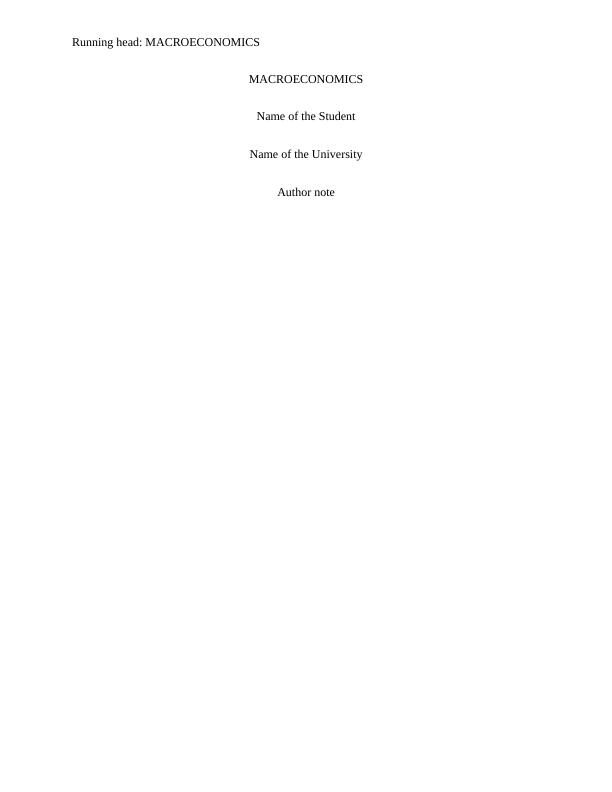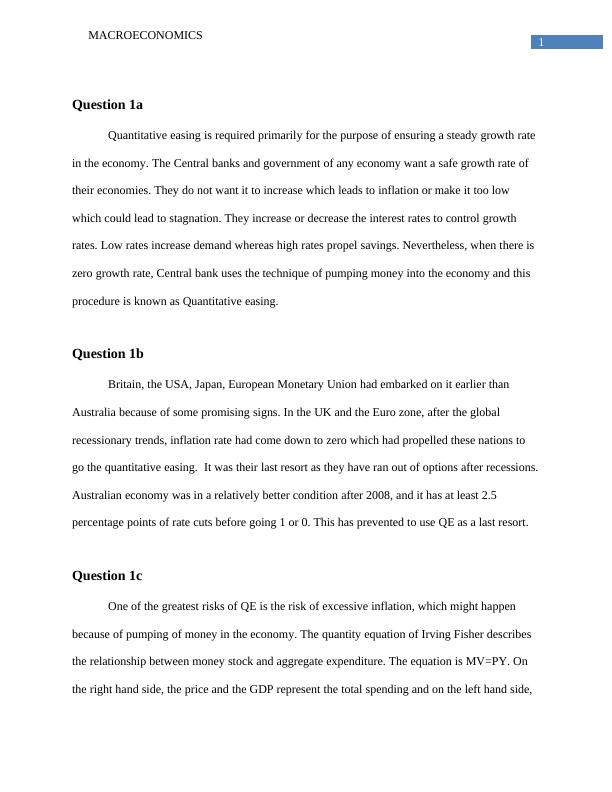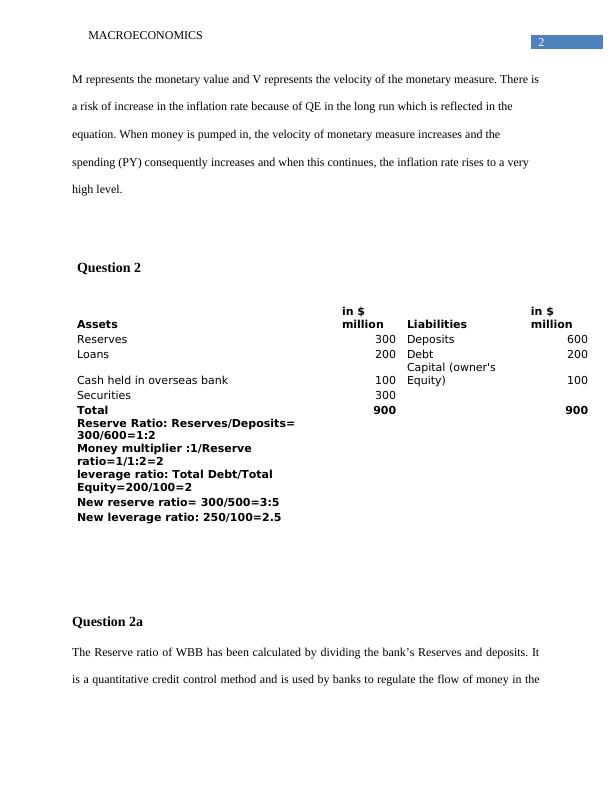Quantitative Easing Macroeconomics
10 Pages1571 Words22 Views
Added on 2021-04-21
Quantitative Easing Macroeconomics
Added on 2021-04-21
ShareRelated Documents
Running head: MACROECONOMICS
MACROECONOMICS
Name of the Student
Name of the University
Author note
MACROECONOMICS
Name of the Student
Name of the University
Author note

1
MACROECONOMICS
Question 1a
Quantitative easing is required primarily for the purpose of ensuring a steady growth rate
in the economy. The Central banks and government of any economy want a safe growth rate of
their economies. They do not want it to increase which leads to inflation or make it too low
which could lead to stagnation. They increase or decrease the interest rates to control growth
rates. Low rates increase demand whereas high rates propel savings. Nevertheless, when there is
zero growth rate, Central bank uses the technique of pumping money into the economy and this
procedure is known as Quantitative easing.
Question 1b
Britain, the USA, Japan, European Monetary Union had embarked on it earlier than
Australia because of some promising signs. In the UK and the Euro zone, after the global
recessionary trends, inflation rate had come down to zero which had propelled these nations to
go the quantitative easing. It was their last resort as they have ran out of options after recessions.
Australian economy was in a relatively better condition after 2008, and it has at least 2.5
percentage points of rate cuts before going 1 or 0. This has prevented to use QE as a last resort.
Question 1c
One of the greatest risks of QE is the risk of excessive inflation, which might happen
because of pumping of money in the economy. The quantity equation of Irving Fisher describes
the relationship between money stock and aggregate expenditure. The equation is MV=PY. On
the right hand side, the price and the GDP represent the total spending and on the left hand side,
MACROECONOMICS
Question 1a
Quantitative easing is required primarily for the purpose of ensuring a steady growth rate
in the economy. The Central banks and government of any economy want a safe growth rate of
their economies. They do not want it to increase which leads to inflation or make it too low
which could lead to stagnation. They increase or decrease the interest rates to control growth
rates. Low rates increase demand whereas high rates propel savings. Nevertheless, when there is
zero growth rate, Central bank uses the technique of pumping money into the economy and this
procedure is known as Quantitative easing.
Question 1b
Britain, the USA, Japan, European Monetary Union had embarked on it earlier than
Australia because of some promising signs. In the UK and the Euro zone, after the global
recessionary trends, inflation rate had come down to zero which had propelled these nations to
go the quantitative easing. It was their last resort as they have ran out of options after recessions.
Australian economy was in a relatively better condition after 2008, and it has at least 2.5
percentage points of rate cuts before going 1 or 0. This has prevented to use QE as a last resort.
Question 1c
One of the greatest risks of QE is the risk of excessive inflation, which might happen
because of pumping of money in the economy. The quantity equation of Irving Fisher describes
the relationship between money stock and aggregate expenditure. The equation is MV=PY. On
the right hand side, the price and the GDP represent the total spending and on the left hand side,

2
MACROECONOMICS
M represents the monetary value and V represents the velocity of the monetary measure. There is
a risk of increase in the inflation rate because of QE in the long run which is reflected in the
equation. When money is pumped in, the velocity of monetary measure increases and the
spending (PY) consequently increases and when this continues, the inflation rate rises to a very
high level.
Question 2
Assets
in $
million Liabilities
in $
million
Reserves 300 Deposits 600
Loans 200 Debt 200
Cash held in overseas bank 100
Capital (owner's
Equity) 100
Securities 300
Total 900 900
Reserve Ratio: Reserves/Deposits=
300/600=1:2
Money multiplier :1/Reserve
ratio=1/1:2=2
leverage ratio: Total Debt/Total
Equity=200/100=2
New reserve ratio= 300/500=3:5
New leverage ratio: 250/100=2.5
Question 2a
The Reserve ratio of WBB has been calculated by dividing the bank’s Reserves and deposits. It
is a quantitative credit control method and is used by banks to regulate the flow of money in the
MACROECONOMICS
M represents the monetary value and V represents the velocity of the monetary measure. There is
a risk of increase in the inflation rate because of QE in the long run which is reflected in the
equation. When money is pumped in, the velocity of monetary measure increases and the
spending (PY) consequently increases and when this continues, the inflation rate rises to a very
high level.
Question 2
Assets
in $
million Liabilities
in $
million
Reserves 300 Deposits 600
Loans 200 Debt 200
Cash held in overseas bank 100
Capital (owner's
Equity) 100
Securities 300
Total 900 900
Reserve Ratio: Reserves/Deposits=
300/600=1:2
Money multiplier :1/Reserve
ratio=1/1:2=2
leverage ratio: Total Debt/Total
Equity=200/100=2
New reserve ratio= 300/500=3:5
New leverage ratio: 250/100=2.5
Question 2a
The Reserve ratio of WBB has been calculated by dividing the bank’s Reserves and deposits. It
is a quantitative credit control method and is used by banks to regulate the flow of money in the

End of preview
Want to access all the pages? Upload your documents or become a member.
Related Documents
Macroeconomicslg...
|12
|1205
|86
Monetary Policy and Quantitative Easinglg...
|6
|1312
|78
Principles of Macroeconomicslg...
|6
|789
|437
